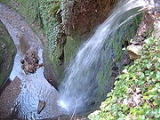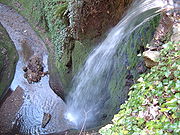
Shanklin Chine
Encyclopedia
Shanklin Chine is a geological feature and tourist attraction in the town of Shanklin
, on the Isle of Wight
, England
. A wooded coastal ravine, it contains waterfalls, trees and lush vegetation, with footpaths and walkways allowing paid access for visitors, and a heritage centre explaining its history.

 A chine
A chine
is a local word for a stream cutting back into a soft cliff. Formation of the Chine, which cuts through Lower Greensand
Cretaceous
sandstones, has taken place over the last 10,000 years. In the latter half of the nineteenth century, stones were laid at the top of the waterfall to arrest this progress. There are a continuous series of spring lines on the cliff faces in the Chine. The Isle of Wight has a number of chines, but the largest remaining is Shanklin. With a drop of 32 m (105 ft) to sea level, and a length of just over 400m (a quarter of a mile), the Chine covers an area of approximately 1.2 hectares (three acres).
and Samuel Howitt
. Descriptions of the site at the time are surprisingly similar to the present day:
trained there in preparation for the Dieppe Raid
in 1942. A fuel pipeline for Operation Pluto
(Pipeline under the Ocean) also ran through the Chine and there are still 65 yards (59.4 m) of the pipe remaining and visible to the public. PLUTO, one of the great secret successes of the war, was the idea of Lord Louis Mountbatten who later became governor of the Isle of Wight. During the Normandy invasion in 1944, forked pipelines from the Chine and Sandown carried petrol 65 miles (104.6 km) under the Channel to Cherbourg.
Shanklin
Shanklin is a popular seaside resort and civil parish on the Isle of Wight, England, located on the east coast's Sandown Bay. The sandy beach, its Old Village and a wooded ravine, Shanklin Chine, are its main attractions. The esplanade along the beach is occupied by hotels and restaurants for the...
, on the Isle of Wight
Isle of Wight
The Isle of Wight is a county and the largest island of England, located in the English Channel, on average about 2–4 miles off the south coast of the county of Hampshire, separated from the mainland by a strait called the Solent...
, England
England
England is a country that is part of the United Kingdom. It shares land borders with Scotland to the north and Wales to the west; the Irish Sea is to the north west, the Celtic Sea to the south west, with the North Sea to the east and the English Channel to the south separating it from continental...
. A wooded coastal ravine, it contains waterfalls, trees and lush vegetation, with footpaths and walkways allowing paid access for visitors, and a heritage centre explaining its history.
Geology


Chine
A chine is a steep-sided river valley where the river flows through coastal cliffs to the sea. Typically these are soft eroding cliffs such as sandstone or clays. The word chine originates from the Saxon "Cinan" meaning a gap or yawn....
is a local word for a stream cutting back into a soft cliff. Formation of the Chine, which cuts through Lower Greensand
Greensand
Greensand or Green sand is either a sand or sandstone, which has a greenish color. This term is specifically applied to shallow marine sediment, that contains noticeable quantities of rounded greenish grains. These grains are called glauconies and consist of a mixture of mixed-layer clay...
Cretaceous
Cretaceous
The Cretaceous , derived from the Latin "creta" , usually abbreviated K for its German translation Kreide , is a geologic period and system from circa to million years ago. In the geologic timescale, the Cretaceous follows the Jurassic period and is followed by the Paleogene period of the...
sandstones, has taken place over the last 10,000 years. In the latter half of the nineteenth century, stones were laid at the top of the waterfall to arrest this progress. There are a continuous series of spring lines on the cliff faces in the Chine. The Isle of Wight has a number of chines, but the largest remaining is Shanklin. With a drop of 32 m (105 ft) to sea level, and a length of just over 400m (a quarter of a mile), the Chine covers an area of approximately 1.2 hectares (three acres).
History
Prior to the Victorian era Shanklin was merely a small agricultural and fishing community, the latter nestling at the foot of the chine, and it was not until the early 19th century that it began to grow. Like most of the chines on the south of the Island, Shanklin Chine was well-used by smugglers.A romantic landscape
The Chine became one of the earliest tourist attractions on the Isle of Wight, with records of the public visiting the site to view it as far back as 1817. Keats found inspiration for some of his greatest poetry while staying at Shanklin in 1819 and wrote: "The wondrous Chine here is a very great Lion; I wish I had as many guineas as there have been spy-glasses in it." It was a favourite subject for artists including Thomas RowlandsonThomas Rowlandson
Thomas Rowlandson was an English artist and caricaturist.- Biography :Rowlandson was born in Old Jewry, in the City of London. He was the son of a tradesman or city merchant. On leaving school he became a student at the Royal Academy...
and Samuel Howitt
Samuel Howitt
Samuel Howitt was an English painter, illustrator and etcher of animals, hunting, horse-racing and landscape scenes. He worked in both oils and watercolors.-Life and work:...
. Descriptions of the site at the time are surprisingly similar to the present day:
'The delightful village of Shanklin. In this sequestered spot is a good inn, fitted up for the accommodation of visitors. The object of attraction at Shanklin is the Chine, (which is situated at about ten minutes walk from the inn. This phenomenon of nature is a combination of beauty and grandeur; it is formed by the separation of a lofty cliff, whose height is 280 feet perpendicular, and 100 feet wide at the top. On entering the Chine from the shore, we pass along one side, rugged and barren; through which a winding path has been cut by a poor fisherman; while below the rippling stream urges its way to the ocean, which pours its rolling waters at its feet, and spreads its boundless expanse before it. On the other side the cliff is fertile, covered with hanging wood and bushes, adorned with a neat cottage, and having a little rustic inn. About the middle of the Chine is a small Chalybeate: and the path now conducts by a serpentine course to a scene of awful grandeur, formed by stupendous masses of matter on each side, and the rustling of a small cascade, which falls from the head of the Chine, and passes between the dark and overhanging cliffs.
Extract from Beauties of the Isle of Wight published by S Horsley 1828
Second World War
During the second world war the Chine was taken over and used as an assault course by the Commandos whose HQ was at Upper Chine School. 40 Royal Marine Commando40 Commando
40 Commando RM is a battalion sized formation of the British Royal Marines and subordinate unit within 3 Commando Brigade, the principal Commando formation, under the Operational Command of Commander in Chief Fleet....
trained there in preparation for the Dieppe Raid
Dieppe Raid
The Dieppe Raid, also known as the Battle of Dieppe, Operation Rutter or later on Operation Jubilee, during the Second World War, was an Allied attack on the German-occupied port of Dieppe on the northern coast of France on 19 August 1942. The assault began at 5:00 AM and by 10:50 AM the Allied...
in 1942. A fuel pipeline for Operation Pluto
Operation Pluto
Operation Pluto was a World War II operation by British scientists, oil companies and armed forces to construct undersea oil pipelines under the English Channel between England and France. The scheme was developed by Arthur Hartley, chief engineer with the Anglo-Iranian Oil Company...
(Pipeline under the Ocean) also ran through the Chine and there are still 65 yards (59.4 m) of the pipe remaining and visible to the public. PLUTO, one of the great secret successes of the war, was the idea of Lord Louis Mountbatten who later became governor of the Isle of Wight. During the Normandy invasion in 1944, forked pipelines from the Chine and Sandown carried petrol 65 miles (104.6 km) under the Channel to Cherbourg.
External links
- Shanklin Chine official website

